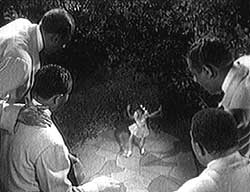 The Mills Brothers in their harmonizing acapella prime do their hit song in the soundie Paper Doll (1942). All the brothers are sitting around in a garden with their girlfriends -- except for one, who is sitting alone with a magazine singing about getting himself a paper doll:
The Mills Brothers in their harmonizing acapella prime do their hit song in the soundie Paper Doll (1942). All the brothers are sitting around in a garden with their girlfriends -- except for one, who is sitting alone with a magazine singing about getting himself a paper doll:
"When I come home at night she will be waiting/ She'll be the truest doll in all this world/ I'd rather have a Paper Doll to call my own/ Than have a fickle-minded real live girl."
The magazine he's looking at has a picture of Dorothy Dandridge, promoting her dance performance at a charity event. Our lead vocalist cuts out the picture, then stands the paper doll upon the ground. Dandridge comes alive to do a dance.
The image of Dorothy Dandridge tiny as a doll dancing as the four Mills Brothers lean around watching is just too charming for words.
The song is a mellow acapella classic, with the brothers faking the instrumentals vocally, for which they were so famed. This was such a big hit they were still singing it on television programs in their old ages, & they could still harmonize nicely even as geezers, but they definitely had a more youthful tone in the 1940s.
The song had been written by Johnny S. Black in 1915 & had just "been around" without relaly being a hit for anyone. When Donald Mills chose to record it, it was only the B side of "I'll Be Around." So it was unexpected when the public preferred the B side, & made "Paper Doll" the biggest of their hits.
They'd recorded it shortly after returning from a long world tour, mostly in Europe, from 1939 to 1941. During their long absence from America, the Ink Spots had risen in fame & pretty much supplanted the Mills Brothers in peopels' hearts, & they'd worried about regaining audience affection -- & sales. "Paper Doll" re-established them as entertainment giants.
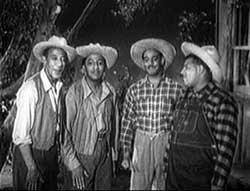 Offensive to a forgiveable degree, the Mills Brothers perform in the garb of hillbillies as they vocally recreate Duke Ellington's classic instrumental Caravan (1942). It's doubtful the brothers had anything to do with the costuming, but had done their arrangement of the swing tune strictly in honor of Ellington, thus sophisticated rather than hick imagery would've been more apropos.
Offensive to a forgiveable degree, the Mills Brothers perform in the garb of hillbillies as they vocally recreate Duke Ellington's classic instrumental Caravan (1942). It's doubtful the brothers had anything to do with the costuming, but had done their arrangement of the swing tune strictly in honor of Ellington, thus sophisticated rather than hick imagery would've been more apropos.
To recreate a big band swing sound with just their mouths is damned clever, but they've also given us a very fine piece of classic harmony.
Given the sophistication of Ellington's composition & the cosmopolitan wittiness of the Mills Brothers' vocal arrangement, dressing them up in a hick setting seems hardly to fit the music. To heighten the unfortunate stereotype there are three "lazy darkies" lounging nearby, a guy & two gals.
These lazy persons have complained that a dance band was supposed to show up for a dance, but isn't going to make it. Only when the Mills Brothers recreate the band vocally does everyone perk up. Slowy one & then the other two & then additional dancers from off screen all get up to dance to "Caravan."
It pretty much turns into a "dancie" instead of a soundie, & if you overlook the stereotyping costuming, this is pretty fine performing, including some breakdance moves from the guy who wins a trophy, though he has to stop eatin' dat watermelon to receive it.
Director Josef Berne worked with many black entertainers & should've known better. But in the context of soundie content of the time, one of the most popular "thread" of soundies content was fake hillbilly music by the likes of the Korn Kobblers & scores of others.
So rather than thinking "lets have some lazy rural darkies with watermelons" I'm sure the point was to have black entertainers horn in on the generally popular honky-hillbillie imagery in many a soundie. And without the weight of history of such imagery crushing down upon it, it would've been no worse (but also no more clever) than when white performers did such acts.
The music at least is good, & the later Mills Brothers soundies to come would forgo storytelling in favor of recording the performance.
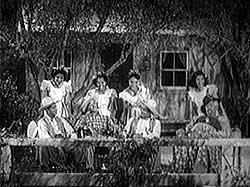 The Mills Brothers perform the Hoagy Carmichael tune Old Rocking Chair (1942) in a "story" context. The guys are sitting in a rocking chairs, wearing lumberjack shirts & straw hats to convey Hoagy's sentimental feelings about country life.
The Mills Brothers perform the Hoagy Carmichael tune Old Rocking Chair (1942) in a "story" context. The guys are sitting in a rocking chairs, wearing lumberjack shirts & straw hats to convey Hoagy's sentimental feelings about country life.
Harry Mills is made up as a geezer, & to some extent they're all acting like old guys who can't get out of their rocking chairs very easily. The song's about aging, facing heaven, & the lord. Yet they're being rocked by beauteous ladies in country pinafores, those lucky bastards.
It's completely acapella & a nice arrangement, but not one of their strongest numbers. Still, when it gets to the "trumpet solo" without a trumpet, that's when it gets cooler'n ratshit.
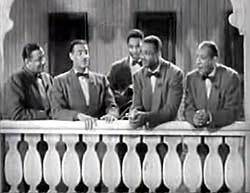 Hoagy Carmichael's nostalgia for rurality was something that suited the Mills Brothers' lowkey approach to vocal arrangement. They made a soundie of Carmichael & Arodin's Lazy River (1944), with just guitar strumming to keep it from being fully acapella. Hoagy Carmichael's nostalgia for rurality was something that suited the Mills Brothers' lowkey approach to vocal arrangement. They made a soundie of Carmichael & Arodin's Lazy River (1944), with just guitar strumming to keep it from being fully acapella.
The tenor lead is supported not just by the excellent harmonizing of the rest of the guys for a really full-bodied sound, but by their vocal instrumentation.
The set is designed to look like they're standing at the railing of a riverboat, with interesting lighting to convey the illusion of the presence of a river reflecting sunlight upon them. But otherwise the "storytelling" of the 1942 soundies (which worked so well on "Paper Doll" but was fairly miserable on "Caravan") is foresworn.
Lazy River is a pretty soundie with a pretty song that lends the viewer & listener a sense of peacefulness. Three minutes of peace in this wartorn world is to be cherished.
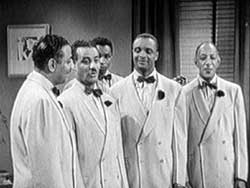 The set for Till Then (1944) is arranged as a living room or private apartment. The Mills Brothers are singing with only rhythm guitar accompaniment, to a few friends. This song, written by Sol Marcus & Guy Wood, reached number eight in the national charts in 1944:
The set for Till Then (1944) is arranged as a living room or private apartment. The Mills Brothers are singing with only rhythm guitar accompaniment, to a few friends. This song, written by Sol Marcus & Guy Wood, reached number eight in the national charts in 1944:
"Till then, my darling please wait for me/ Till then, no matter when will be/ One day I know I'll be back again/ Please wait till then.
"Our dreams will live though we are apart/ Our love -- I know we'll keep in our heart/ Till then, when all the world will be free/ Please wait for me."
It's the Mills Brothers' classic arranging style that they used time & again, with tenor lead & a combination of harmonizing support & humming vocal instrumentation & horn-impersonation. It was a method that they didn't adhere to strictly for everything, but it played well for them in a number of hits that even after all these years come across as wonderful & sweet.
Again the story vignettes of earlier soundies is foresworn in favor of just singing, with close-up portraits of each brother provided throughout.
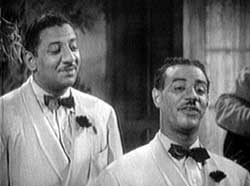 This soundie was made into part of a three-soundie one-reel film called Lazy Rhythms (1947), together with their soundies for Lazy River & Old Rocking Chair. This soundie was made into part of a three-soundie one-reel film called Lazy Rhythms (1947), together with their soundies for Lazy River & Old Rocking Chair.
Given a comfy porch setting for the soundie You Always Hurt the One You Love (1944), the brothers present a truly classic performance of quiet dignified charm. Halfway through the number they pick up the pace for a bouncier replay, combining solos & full harmonies in a careful balance.
This is probably the best cover of all time of the great love song: "You always hurt the one you love/ The one you shouldn't hurt at all/ You always hurt the sweetest rose/ And crushed it till the petals fall."
This one was incorporated into a three-soundie Official Films one-reeler called Sepian Stars on Parade (1947). The other two inclusions were Bill Bojangles Robinson's Let's Shuffle (1942) in which he both sings & dances; & Bob Howard's She's Too Hot to Handle (1944).
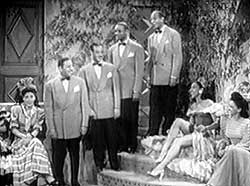 Arrayed upon a staircase overlooking a pleasant living-room setting, with Spanish senioritas to sing for, the Mills brothers do a jazz-beat acapella plus rhythm guitar performance of Cielito Lindo (1944). The guitarist is glimpsed stage-right at the beginning, but thereafter the camera shows the harmonizing quintet only.
Arrayed upon a staircase overlooking a pleasant living-room setting, with Spanish senioritas to sing for, the Mills brothers do a jazz-beat acapella plus rhythm guitar performance of Cielito Lindo (1944). The guitarist is glimpsed stage-right at the beginning, but thereafter the camera shows the harmonizing quintet only.
In 1944 there were five "brothers" though when the 1944 soundies were made, there were only two literal brothers singing, Herbert Mills & Donald Mills. Harry had been drafted, replaced for a couple years by Gene Smith. Fourth is their father, John Sr, as baritone & fake "tuba" though to me he often sounds like a double-bass.
Fifth is the guitarist. Originally their brother John Jr. accompanied the group on ukelele or guitar, but he died in 1936, so in the later years, it was Norman Brown.
It's a jaunty nice performance, an English language version of a Spanish langauge classic. It was never one of my favorite numbers. If not for the trademark faked trumpet & other instrumentation including dad's poomp-poomp-poomp bass or tuba rift, it wouldn't be that good.
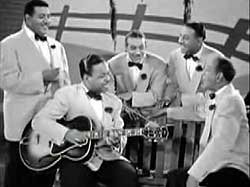 There is an additional soundie-like clip circulating of the Mills Brothers doing this number. It's a performance from the movie Reveille with Beverly (1943). The fact is, though, the Mills Brothers aren't really "in" the movie, & the clip is "complete in itself" because framed as its own mini-film. There is an additional soundie-like clip circulating of the Mills Brothers doing this number. It's a performance from the movie Reveille with Beverly (1943). The fact is, though, the Mills Brothers aren't really "in" the movie, & the clip is "complete in itself" because framed as its own mini-film.
This was done, sad to say, so that the Mills Brothers could be clipped out of the film for distribution to segragated southern cinema houses, a sad outcome of a Production Code that regarded mixed race casts as promoting "miscegenation." This is also why the Duke Ellington Orchestra appears in a segregated train car. If all the removable numbers were taken out of the film for some venues, there'd be nothing worthwhile left.
As "Cielito Lindo" is about to begin, a Decca record is shown spinning on a turntable. The hole in the center grows larger & larger until we see the Mills Brothers on stage.
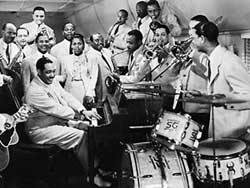 The expressionist backdrop is made to look like a rural setting, with streamers of Spanish moss hanging down to cue us to the idea this is the rural south, though the song is about Spain. The expressionist backdrop is made to look like a rural setting, with streamers of Spanish moss hanging down to cue us to the idea this is the rural south, though the song is about Spain.
With just the guitar accompaniment the five guys are all center stage. They sing of some remembered "sweet seniorita" encountered at a fiesta, a romantic tale of "romance & all its glory."
As the song ends, suddenly we're in a record shop & Ann Miller is telling the salesman, "Wrap it up!"
The Ann Miller vehicle isn't much of a film. She plays Beverly Ross, radio disc jockey. She's courted by two guys, one rich, one not rich, both destined to become soldiers. The story is a tad more than an excuse to show what kind of music gets on the radio. And it must be said she has good taste in music.
Duke Ellington plays his orchestra's classic "Take the 'A' Train." Ella Mae Morris sings the excellent "Cow Cow Boogie." Count Basie plays "One O'Clock Jump." The Mills Brothers have a second song, "Sweet Lucy Brown."
Frank Sinatra turns for the Cole Porter tune "Night & Day," assisted by a a dozen women, six on violins, six on grand pianos. The least of the lot are Ann Mille singing "Thumbs Up & V for Victory" & dancing while she's at it, & Lyn Wilde singing "Big Noise From Winnetka."
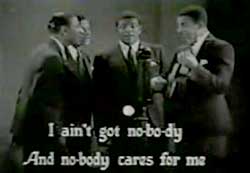 I Ain't Got Nobody (1932) is a "follow the bouncing ball" partly live-action featuring the Mills Brothers performing with the bouncing ball lyrics underneath them, & part animated cartoon, in black & white. It's sweet to see the brothers this young.
I Ain't Got Nobody (1932) is a "follow the bouncing ball" partly live-action featuring the Mills Brothers performing with the bouncing ball lyrics underneath them, & part animated cartoon, in black & white. It's sweet to see the brothers this young.
Apart from minimal guitar rhythm, the only musical instruments are the ones they fake with their vocals. You hear them doing this immediately behind the title card & it's amazing how "cartoon appropriate" their sound is. Kids & adults alike across America, in the theater houses the era, must've been amazed & delighted.
They get their own title card, which reads, "Presenting for the first time on the screen, Radio's greatest sensation, The Mills Bros." A third card explains that the musical instruments we will hear do not exist, except for the guitar, "there is no tuba, no trumpet, & no saxophone." This is a restatement of the explanation that accompanied their live regular radio performances.
The cartoon itself is great. The animated portion begins with a lion character tuning his television. This is 1932. Very primitive televisions had been experimented with since the start of the century & began to have hints of real promise in the 1920s. But what this black & white cartoon is showing is something the general public wouldn't've have seen until the first mass-audience demonstration at the 1934 World's Fair. By 1936 a scant 200 television sets were in use world-wide, these in small clusters very near a transmission source.
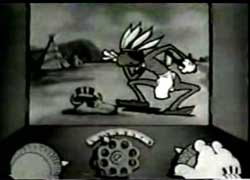 Generally speaking, televisions would not be available for the masses, with something on the air worth picking up, until the early 1950s. Yet there it is in a 1932 cartoon, clearly labeled across the top "Television," a box that brings in pictures with the turn of dials. Generally speaking, televisions would not be available for the masses, with something on the air worth picking up, until the early 1950s. Yet there it is in a 1932 cartoon, clearly labeled across the top "Television," a box that brings in pictures with the turn of dials.
The lion tinkers with the controls until a jungle scene comes clear, of stereotypical cannibals trying to stuff a dog-character into a big iron cauldron. I always wondered about those cauldrons. Were they manufactured by Acme Cartoon-Cannibal Novelties? Kind of like the rifles the primitive aliens on Barsoom possessed (in old John Carter on Mars novels), we just never do find out who makes those rifles.
The lion goes on down the dial & finds other programs, a Mexican guy slipping on some tiles which must've meant something at the time but made no sense to me; & an Indian in a desert next to a steer's skull in tophat.
Finally he settles on a station that is showing the Mills Brothers. The lion begins jive-dancing around the room & hypnotizing the teapot while the brothers on the television do a very interesting introductory piece of scat-jazz.
The scatting turns into "Hold that Tiger," while the lion hypnotizes a picture hanging on the wall into coming to life. A bird, singing & hopping around the room, lays eggs, & other nutty surrealist things occur.
The lion begins lip-syncing the scat routine in "Hold that Tiger" while bringing statues to life, making a breakfast cook itself, & doing other magical things. A mouse plays a tiny trumpet which is actually the Mills Brothers vocalizing.
The lion gazes out at the audience to hypnotize us & says, "When the Mills Brothers ask you to sing, you must sing along." We get to see them on the telly again, singing to the tune of "I Ain't Got Nobody" the following invitation:
"Weeee are just four singers/ Who sing like a real live band/ Iiiiiiif you'd like to join us/ Won't everybody sing along using your own hands/ Don't use a corenet or violin/ If you sing loud, folks, you're sure to win/ Sing I ain't got nobody/ When the ball bounces, all join in."
The follow-the-ball song concludes & the film concludes with animation of a tiger rug coming to life to "Hold that Tiger" & chasing the lion out of his own house.
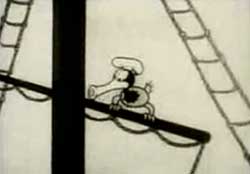 Delightful throughout, the cartoon is amusing & the Mills Brothers are sweeter'n jam. Delightful throughout, the cartoon is amusing & the Mills Brothers are sweeter'n jam.
They follwed up their first screen appearance with two more "Sing Alongs" from Fleischer Studios, When Yuba Plays the Rumba on the Tuba (1933) which I've never been able to see, & Dinah (1933). They're also on the soundtrack of Betty Boop & Grampy (1935) with "Tiger Rag."
In Dinah the Mills Brothers again appear live during the dancing-ball sing-along, having again been introduced as having no musical instruments despite how it sounds. The animated portion is about animals on board a ship called the Dinah Lee. Life on board the ship is mostly fun with plenty of sight-gags, goin' fishin' & swimmin', hanging the sails, & a bird with a horn for a beak that makes Mills Brothers trumpet sounds.
copyright © by Paghat the Ratgirl
|




 Hoagy Carmichael's nostalgia for rurality was something that suited the Mills Brothers' lowkey approach to vocal arrangement. They made a soundie of Carmichael & Arodin's Lazy River (1944), with just guitar strumming to keep it from being fully acapella.
Hoagy Carmichael's nostalgia for rurality was something that suited the Mills Brothers' lowkey approach to vocal arrangement. They made a soundie of Carmichael & Arodin's Lazy River (1944), with just guitar strumming to keep it from being fully acapella.
 This soundie was made into part of a three-soundie one-reel film called Lazy Rhythms (1947), together with their soundies for Lazy River & Old Rocking Chair.
This soundie was made into part of a three-soundie one-reel film called Lazy Rhythms (1947), together with their soundies for Lazy River & Old Rocking Chair.
 There is an additional soundie-like clip circulating of the Mills Brothers doing this number. It's a performance from the movie Reveille with Beverly (1943). The fact is, though, the Mills Brothers aren't really "in" the movie, & the clip is "complete in itself" because framed as its own mini-film.
There is an additional soundie-like clip circulating of the Mills Brothers doing this number. It's a performance from the movie Reveille with Beverly (1943). The fact is, though, the Mills Brothers aren't really "in" the movie, & the clip is "complete in itself" because framed as its own mini-film. The expressionist backdrop is made to look like a rural setting, with streamers of Spanish moss hanging down to cue us to the idea this is the rural south, though the song is about Spain.
The expressionist backdrop is made to look like a rural setting, with streamers of Spanish moss hanging down to cue us to the idea this is the rural south, though the song is about Spain.
 Generally speaking, televisions would not be available for the masses, with something on the air worth picking up, until the early 1950s. Yet there it is in a 1932 cartoon, clearly labeled across the top "Television," a box that brings in pictures with the turn of dials.
Generally speaking, televisions would not be available for the masses, with something on the air worth picking up, until the early 1950s. Yet there it is in a 1932 cartoon, clearly labeled across the top "Television," a box that brings in pictures with the turn of dials. Delightful throughout, the cartoon is amusing & the Mills Brothers are sweeter'n jam.
Delightful throughout, the cartoon is amusing & the Mills Brothers are sweeter'n jam.